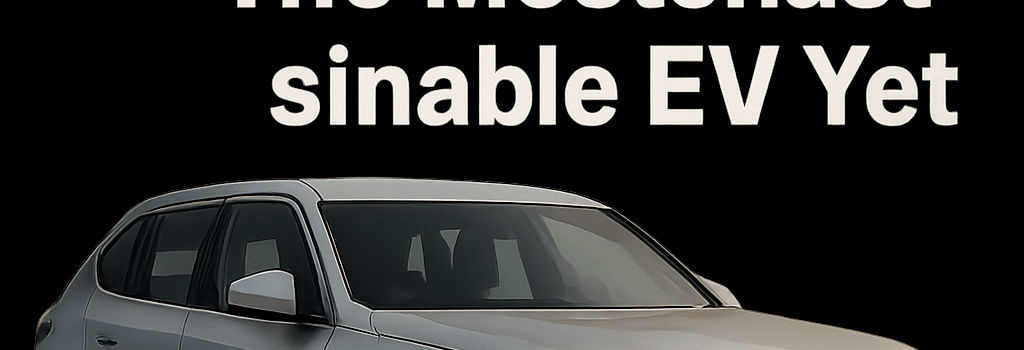BMW’s Neue Klasse iX3: The Most Sustainable EV Yet

When BMW’s next-generation iX3 arrives in Europe later in 2025 (and in North America in early 2026), it will mark more than a facelift—it will be the first production EV built on BMW’s all-new Neue Klasse architecture. By combining advanced materials, groundbreaking battery technology and a fully renewable energy–powered assembly plant, BMW claims this will be its most sustainable car ever. Here’s an in-depth look at what makes the new iX3 a milestone in zero-emission mobility.
Neue Klasse: Heritage Meets Cutting-Edge Platform
Named in homage to the iconic 1960s Neue Klasse sedans, this modular EV platform integrates the electric powertrain, battery pack and digital backbone into a slim “skateboard” chassis. Key technical highlights include:
- Modular Architecture: Scalable wheelbase (2,850–3,050 mm) and track widths allow for crossovers through sedans to luxury SUVs, enabling weight savings of up to 100 kg versus current underpinnings.
- Integrated High-Voltage Network: A 800 V system reduces cable gauge and overall wiring weight by 25 %, while supporting ultra-fast charging up to 350 kW.
- Digital Twin & Industry 4.0: Real-time simulation of the entire assembly line at the Debrecen plant supports predictive maintenance. Automated guided vehicles (AGVs) and collaborative robots have reduced assembly cycle time by 15 % and energy use by 20 %.
Industry 4.0 in Debrecen: A Carbon-Neutral Factory
BMW’s new 320,000 m² plant in Debrecen, Hungary, runs entirely on renewable electricity from local wind and solar farms. Highlights include:
- Electric Paint Shop: Replaces traditional gas ovens with induction curing, cutting CO₂ emissions per vehicle by 60 %.
- On-Site Photovoltaics: A 50 MW rooftop array and adjacent solar park generate 70 GWh/year—enough to power over 25,000 EVs annually.
- Water Recycling: Closed-loop water treatment captures 98 % of process water for reuse in stamping and cooling.
Advanced Materials & Circular Economy
Building on lessons from the i Vision Circular concept, the iX3 employs “mono-material” assemblies to simplify end-of-life recycling:
- Center Console: Formed from a single polypropylene compound—eliminating mixed plastics and boosting recyclability by 40 %.
- Recycled Content: 740 kg of secondary materials per vehicle, including:
- 50 % of battery cathode metals (Li, Co, Ni) from closed-loop recycling partners
- 70 % secondary aluminum in alloy wheels and 80 % in wheel carriers
- Frunk tub made with 30 % recycled fishing nets transformed into plastic pellets
Dr. Maria Klein, BMW Head of Sustainability: “By converging lightweight mono-materials with high-performance secondary metals, we’re reducing the iX3’s full lifecycle CO₂ footprint by over 50 % compared to the previous-gen X3.”
Next-Gen Battery & Powertrain Efficiency
At the heart of the Neue Klasse is a new cylindrical cell (80 mm × 2170 mm) delivering over 300 Wh/kg—10 % more than BMW’s 5th-gen prismatic cells. Technical specs include:
- Reduced Carbon Intensity: 42 % lower CO₂ per kWh versus prismatic cells, achieved by switching to green hydrogen‐based cathode calcination and localized electrode production.
- Cooling Innovation: Direct cell immersion with non-flammable dielectric fluid improves thermal uniformity, enabling sustained 3C discharge rates without overheating.
- Drivetrain: Sixth-generation electric motor with SiC (silicon carbide) inverters yields a peak efficiency of 96 %, lowering energy consumption to 17 kWh/100 km (WLTP).
Break-Even Analysis: Using Europe’s average grid mix (~300 g CO₂/kWh), the iX3 reaches parity with a diesel X3 in ~13,300 km. When charged exclusively with renewables, the crossover point drops to ~17,500 km—about one year of typical use.
Deep Dive: Digitalization & Connectivity
Beyond hardware, the Neue Klasse features an AI-driven Energy Management ECU that learns your driving style and optimizes battery temperature and charge rates in real time. Over-the-air (OTA) updates refine regenerative braking algorithms, improving single-charge range by up to 5 % after launch. A new zonal E/E architecture consolidates 70 % of legacy ECUs into four high-performance domain controllers, reducing wiring complexity by 60 % and weight by 15 kg.
Market Implications & Regulatory Context
The Neue Klasse iX3 arrives as the EU tightens CO₂ limits under its Fit for 55 package and the US introduces stricter battery sourcing due diligence in line with the CSDDD. Moreover, US buyers may qualify for the full $7,500 IRA tax credit thanks to the local content of critical minerals. This positions BMW to meet its 2030 target of a 27 % reduction in Scope 1–3 emissions versus 2019 levels.
Conclusion
With its Neue Klasse iX3, BMW is demonstrating how vertical integration—from green steel and low-carbon battery cells to renewable-powered factories and circular design—can deliver a truly sustainable EV at scale. When it goes on sale in late 2025, the new iX3 won’t just be another electric crossover—it will be the blueprint for all future BMW EVs.